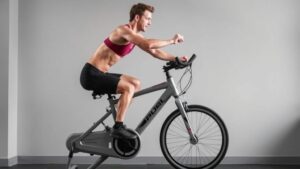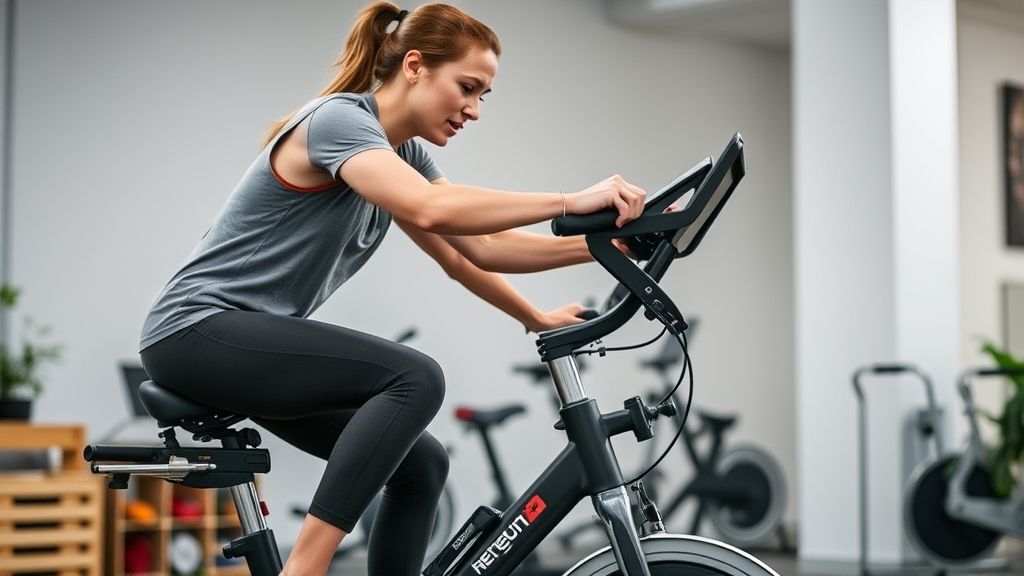Hop on a stationary bike and start pedaling—it might feel like you’re just getting a good cardio session in, but your muscles are working overtime. Whether you’re biking at the gym or grinding through a spin class, this low-impact workout does more than burn calories. Does a Stationary Bike Work
It strengthens, tones, and sculpts a range of muscles across your lower and upper body. But what muscles does a stationary bike work? Let’s dive in!
Primary Muscle Groups Worked
Quadriceps (Front Thighs)
When you push the pedal down, your quadriceps—located at the front of your thighs—do the heavy lifting. This is especially true during the downward part of your pedal stroke. With consistent riding, your quads will not only get stronger but also more defined.
Hamstrings (Back Thighs)
Your hamstrings engage during the upward motion of the pedal stroke. While they’re not working as hard as your quads, they play a crucial role in balancing leg strength and improving the smoothness of your ride.
Gluteus Maximus (Glutes/Butt)
Want a firmer, lifted butt? Good news—the glutes get a serious workout on a stationary bike. When you increase resistance or stand up on the pedals, your glutes activate to power your movement, helping you sculpt and strengthen them.
Calves (Lower Legs)
Your calves, particularly the gastrocnemius and soleus muscles, work hard to keep the pedal motion smooth. Whether you’re riding fast or slow, your calves are always engaged to help stabilize and push.
Secondary Muscle Groups Activated
Hip Flexors
These muscles, located near your pelvis, are key for lifting your knees and powering each upward pedal stroke. The more aggressive your cycling (like in spin class), the more they get involved.
Core Muscles
You might not realize it, but your abs are hard at work stabilizing your upper body. A strong core helps you maintain proper form and balance, especially if you’re riding without holding onto the handlebars.
Lower Back Muscles
Your lower back supports your posture throughout the ride. Poor posture can lead to strain here, but proper form strengthens these muscles over time.
Shoulders and Arms (Indirectly)
While not primary targets, your shoulders, biceps, and triceps engage slightly, especially when you’re gripping the handlebars or doing a standing climb. This helps improve upper-body endurance and posture.
Stationary Bike Types and Muscle Emphasis
Upright Bike
Mimics the posture of a traditional bicycle. It engages the core and back more than a recumbent bike and provides a better all-around leg workout.
Recumbent Bike
Offers more support and is easier on the lower back. It emphasizes the thighs and glutes but engages the core less due to the reclined position.
Spin Bike/Indoor Cycling Bike
Designed for high-intensity training. You’ll use a broader range of muscles, especially when you stand and pedal or increase resistance.

How Cycling Technique Affects Muscle Engagement
Seated vs Standing Pedaling
Seated: Focuses more on quads and hamstrings.
Standing: Increases engagement of glutes, core, and calves.
Resistance Levels and Their Impact
Higher resistance means greater muscle activation. Think of it like biking uphill—your legs and glutes work harder, mimicking a strength training effect.
Pedal Stroke Technique (Push vs Pull)
Push phase: Activates quads.
Pull phase: Engages hamstrings and hip flexors (especially with clip-in pedals).
Mastering a smooth, circular pedal stroke balances muscle work and improves efficiency.
Benefits of Strengthening These Muscles
Improved Endurance
Stronger muscles mean you can bike longer and recover faster. The more you ride, the better your muscles perform—on and off the bike.
Better Balance and Posture
With strong core, hip, and leg muscles, you’ll maintain better posture while biking and in daily life.
Joint Support and Injury Prevention
Stationary bikes are low-impact. Strong leg muscles support your knees, hips, and ankles, reducing the risk of injury during workouts or even walking and climbing stairs.
Toned Legs and Glutes
Let’s be honest—who doesn’t want sculpted legs and a firm butt? Biking is one of the best ways to tone without bulk.
Workout Tips to Maximize Muscle Activation
Adjusting Resistance and Speed
Low resistance + high speed = cardio and endurance
High resistance + moderate speed = strength and toning
Mix them both for full benefits.
Interval Training for Strength and Definition
Alternate between high-intensity sprints and recovery periods. This method torches calories and challenges your muscles.
Using Correct Form and Posture
Keep your back straight, abs tight, and hands relaxed on the handlebars. Engage your core, not your shoulders, for stability.

Complementary Exercises for Stationary Biking
Stretching After Cycling
Stretch your quads, hamstrings, calves, and hips after each ride. It reduces soreness and keeps you flexible.
Strength Training for Balanced Development
Complement biking with strength workouts:
Lunges and squats for legs and glutes
Planks for the core
Dumbbell rows for the back
This ensures you don’t overdevelop one area and neglect others.
Conclusion
So, what muscles does a stationary bike work? In short—a lot. From your quads to your calves, and even your core, riding a stationary bike activates and tones multiple muscle groups. Whether you’re aiming for endurance, strength, or just to feel good in your jeans, this workout is a powerhouse for your lower body—and more. With proper technique and consistent effort, you’ll be pedaling your way to a stronger, leaner you.
FAQs
- Does cycling build muscle or just tone?
It mostly tones and strengthens muscles. With higher resistance and longer sessions, it can build lean muscle mass too. - Is cycling on a stationary bike good for belly fat?
While biking doesn’t directly target belly fat, it helps burn calories and reduce overall body fat—including belly fat—with consistency. - How long should I ride a stationary bike to see results?
Aim for 30–45 minutes, 3–5 times per week. Results can appear in 3–6 weeks, depending on your intensity and diet. - Does a stationary bike help with knee strength?
Yes! It’s a low-impact way to strengthen the muscles around the knees, improving stability and reducing pain over time. - Which is better for muscle tone—spin bike or recumbent bike?
Spin bikes offer more intense workouts and greater muscle activation, especially in the glutes and core, making them better for toning. Does a Stationary Bike Work

